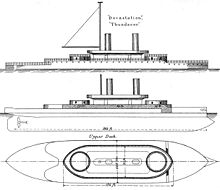- Devastation class ironclad
-
For the French ironclads with a similar name, see Dévastation class ironclad.

HMS Devastation in 1896Class overview Completed: 2 General characteristics Displacement: 9,188 tons Length: 285 ft (87 m) Beam: 62 ft 3 in (19 m) Draught: 27 ft 6 in (8 m) Propulsion: Two coal fired Penn trunk engines, 2 screws Speed: 13 knots (24 km/h) maximum Range: 4,700 nautical miles (8,700 km) Complement: 410 Armament: As built: 4 × 12-inch (305 mm) rifled muzzle-loading guns mounted in two turrets
From 1890: 4 × BL 10-inch (254.0 mm) gunsArmour: Turrets: 15 inches (380 mm)
12 inches (300 mm) on partial belt reducing to 10 inches (250 mm) at ends
3 inches (76 mm) on curved deckThe two British Devastation-class battleships of the 1870s were the first class of ocean-going capital ship that did not carry sails, and the first which mounted the entire main armament on top of the hull rather than inside it. For the first fifteen years of their lives, they were the most powerful warships in the world.
Contents
Design
The genesis of the design was a request by the First Lord of the Admiralty Hugh Childers to the head of ship design at the Admiralty, Edward Reed in early 1869 for a large breastwork monitor which could steam from Queenstown (now Cobh) in Ireland to Halifax in Canada. At a meeting shortly afterwards of the Admiralty board it was agreed that the ship should have two 12-inch (305 mm) guns firing 600-pound (270 kg) shells mounted in each of two turrets protected by 14 inches (360 mm) of armour, which would each have a 280 degree field of fire. The ship would be protected by a 12-inch (300 mm) thick armour belt around the waterline.
A very low freeboard of 4 feet 6 inches (1.4 m) was agreed since the ship was now intended for coastal service in waters around the United Kingdom or service in the relatively calm Mediterranean. Twin steam engines and twin screws were felt necessary for security, and there was a strong feeling that masts and sails should be eliminated to reduce interference with the field of fire of the turrets, but their absence meant that the vessel could not operate far away from friendly coaling stations.
A replica of the proposed turret was constructed and tested at Shoeburyness in May 1872. The 11-inch (280 mm) armour plate backed by 15 inches (380 mm) of teak and a 1.25-inch (32 mm) metal skin resisted hits from a 25 ton gun firing at a range of 200 yards (180 m), although one shot hit a joint between plates and opened a gap 7 inches (180 mm) wide but did not penetrate.
The loss of HMS Captain in 1870 led to concerns about the stability of turret ships, and a committee was set up to determine whether HMS Devastation would be safe. One effect of this was to extend the armoured breastwork with unarmoured structure to the sides of the ship and carried aft to improve the stability at large angles of heel. This greatly improved the crew comfort by adding extra accommodation and especially latrines, but since it was not armoured would have been riddled in a battle reducing the stability of the vessel.
In 1871 a 9-foot (2.7 m) long model of Devastation was tested in a water tank, and subsequently with an 18-foot (5.5 m) long version. Once Devastation was completed, tests could be carried out with the real ship. This included building up a roll of 7 degrees by having 400 men run backwards and forwards across the deck 18 times. Other tests involved taking it to sea to look for rough weather, in one trial waves of 20-26 feet (6-8 m) were encountered which gave the ship a 14 degree roll either way.
See also
References
- David Brown, Warrior to Dreadnought: Warship development 1860-1905, Chatham Publishing.
External links
List of battleships of the Royal Navy Categories:- Battleship classes
- Devastation class battleships
- Victorian era battleships of the United Kingdom
Wikimedia Foundation. 2010.

